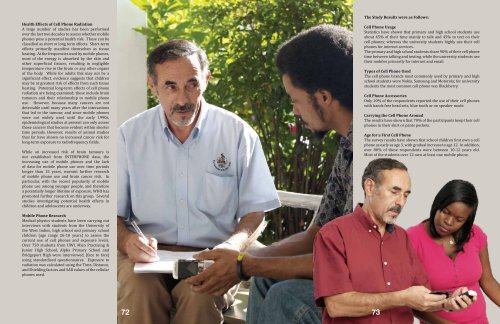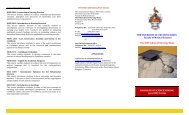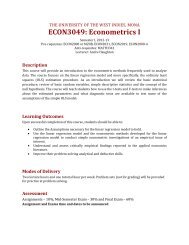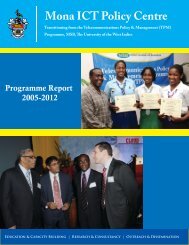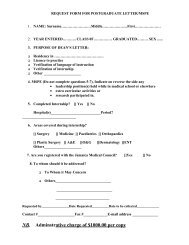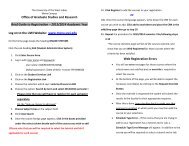Download Pdf - Uwi.edu
Download Pdf - Uwi.edu
Download Pdf - Uwi.edu
- No tags were found...
Create successful ePaper yourself
Turn your PDF publications into a flip-book with our unique Google optimized e-Paper software.
Health Effects of Cell Phone RadiationA large number of studies has been performedover the last two decades to assess whether mobilephones pose a potential health risk. These can beclassified as short or long term effects. Short-termeffects primarily manifest themselves as tissueheating. At the frequencies used by mobile phones,most of the energy is absorbed by the skin andother superficial tissues, resulting in negligibletemperature rise in the brain or any other organsof the body. While for adults this may not be asignificant effect, evidence suggests that childrenmay be at greatest risk of effects from such tissueheating. Potential long-term effects of cell phoneradiation are being examined; these include braintumours and their relationship to mobile phoneuse. However, because many cancers are notdetectable until many years after the interactionsthat led to the tumour, and since mobile phoneswere not widely used until the early 1990s,epidemiological studies at present can only assessthose cancers that become evident within shortertime periods. However, results of animal studiesthus far have shown no increased cancer risk forlong-term exposure to radiofrequency fields.While an increased risk of brain tumours isnot established from INTERPHONE data, theincreasing use of mobile phones and the lackof data for mobile phone use over time periodslonger than 15 years, warrant further researchof mobile phone use and brain cancer risk. Inparticular, with the recent popularity of mobilephone use among younger people, and thereforea potentially longer lifetime of exposure, WHO haspromoted further research on this group. Severalstudies investigating potential health effects inchildren and adolescents are underway.The Study Results were as Follows:Cell Phone UsageStatistics have shown that primary and high school students useabout 45% of their time mainly to talk and 45% to text on theircell phones; whereas the university students highly use their cellphones for internet services.The primary and high school students share 90% of their cell phonetime between talking and texting, while the university students usetheir mobiles primarily for internet and email.Types of Cell Phone UsedThe cell phone brands most commonly used by primary and highschool students were Nokia, Samsung and Motorola; for universitystudents the most common cell phone was Blackberry.Cell Phone AccessoriesOnly 10% of the respondents reported the use of their cell phoneswith hands free head sets, blue tooth or on speaker mode.Carrying the Cell Phone AroundThe results have shown that 70% of the participants keep their cellphones in their skirt or pants pockets.Age for a First Cell PhoneThe survey results have shown that school children first own a cellphone as early as age 3, with gradual increase to age 12. In addition,over 80% of these respondents were between 10-12 years old.Most of the students over 12 own at least one mobile phone.Mobile Phone ResearchMedical physics students have been carrying outinterviews with students from the University ofthe West Indies, high school and primary schoolchildren (age range 26-10 years) to assess thecurrent use of cell phones and exposure levels.Over 750 students from UWI, Mico Practising &Junior High School, Alpha Primary School andBridgeport High were interviewed, [face to face]using standardised questionnaires. Exposure toradiation was calculated using the Time, Distance,and Shielding factors and SAR values of the cellularphones used.72 73


